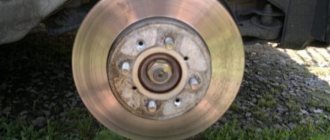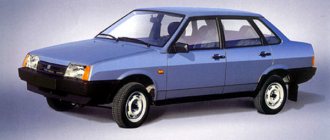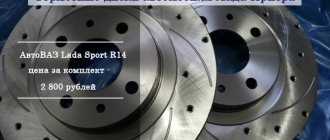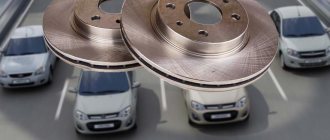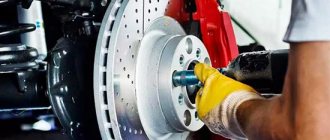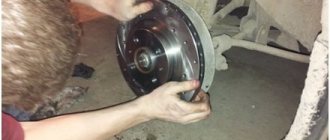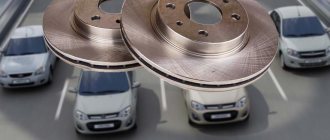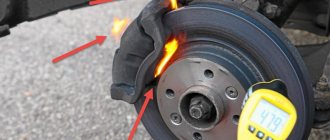Before you understand why the front brake discs get hot, you need to understand the general mechanism of how the brakes work. We will determine the main causes and consequences that overheating leads to.
Disc brakes provide reliability, performance and are easy to maintain. Due to this, they are installed on most modern cars. There are front and rear brake discs. The principle of operation is that a caliper acts on the pads and presses them with its piston. In turn, the pads clamp the disc. The energy of movement turns into heat, and the car slows down until it comes to a complete stop (depending on the compression force). This generates a lot of heat, so the pads and discs get hot. In case of sudden braking, smoke may even come out.
Compound:
- brake disk;
- pads;
- calipers;
- cylinder with piston;
- protective casing;
- other elements.
The material is cast iron. It is inexpensive and has good friction properties. However, there is also a drawback. From frequent use, the pads become very hot, the top layer melts, followed by warping. And when water gets in, discs heated to several hundred degrees easily crack. The solution to the situation was ventilated brakes and brakes made of steel alloys.
Basic requirements for disks:
- strength;
- thermal conductivity;
- resistance to thermal shock;
- low adhesion - ability to stick;
- stability when heated to high temperatures.
When the front or rear brakes become too hot, the clutch in the pad-disc pair is lost, and the first one simply slides along the surface of the second one. The braking function is not performed.
How to tell if a brake disc is getting hot
Discs are one of the key elements of a vehicle’s braking system. They are usually made of cast iron and operate using a clamping mechanism, in conjunction with which there are also pads. When braking, the latter come into contact with the discs, slowing down the vehicle. At the same time, the disks heat up. In some cases they overheat. A driver with solid experience can determine this without difficulty. Beginners often do not pay attention to the “signals” that the car gives when the brake discs overheat.
Among the first symptoms of this problem:
- the appearance of sounds reminiscent of creaking or squeaking;
- The car does not pick up speed when driving in neutral downhill
- sudden increase in fuel consumption;
- rapid pad wear.
If you detect at least one of these signs, check the temperature in the area of the disks to confirm your suspicions. To do this, drive 300-400 meters, braking periodically. Stop and bring your hand to the disc area. Just don't touch it, otherwise you will get a severe burn. Normally, their temperature should be about 200-300°C. When overheated, it increases significantly, so you will feel the intense heat from the disks even at a distance.
If you don’t trust your feelings, use a special device to measure your temperature. It can be purchased at an auto store.
Experienced drivers can detect constant overheating even without instruments. All they have to do is inspect the discs, the color of which will tell a lot. So, at a constant temperature of 150-300 ° C, steel turns yellow. The wheels look like they are rusty and this scares many car enthusiasts. In fact, this is a normal reaction of steel to increased temperature. And 200-300°C when the braking system is operating is normal, so there is no need to worry. The blue or black color of the discs should alert you. They become like this with a “chronic” increase in temperature to 400-500°C.
If you suspect overheating of the discs, do not be too lazy to have the brake system diagnosed at a trusted car service center. Your life and that of other road users literally depends on its serviceability.
Possible consequences
The main consequences of overheating are poor performance of the braking system. The pad will slide over the hot disc without proper grip, the car will not stop at the right time and an accident or other unforeseen situation may occur. After several acceleration-braking cycles, when the brakes are heated to 400-450 degrees, they may disappear completely until they cool completely. Overheating of the discs will lead to boiling of the brake fluid and, as a result, complete failure of the system.
The dangers of overheating brake discs
A hot disk loses its main function. The pads slide along its surface and do not cling. As a result, the car becomes uncontrollable due to lack of proper braking.
In addition, temperatures above normal deform the disk. If even small drops of water get in contact with it, it can become cracked and even crumble.
Air in the brakes
If there is air in the brake system, the pistons are damaged and therefore cannot return to their original position. And this in turn leads to heating of metal products located nearby.
Often this problem can be observed in a car that has previously undergone repairs, during which fluid was completely or partially drained or added. When such actions are carried out, drivers should be aware of the mandatory bleeding of the system, due to which air trapped inside is removed. If these actions are carried out incorrectly, the discs may heat up, the brake pedal may fail, and the effectiveness of the entire braking system may decrease.
It is impossible to determine the presence of air, so if the driver has suspicions, he needs to re-pump, based on the recommendations of the car manufacturer. This is usually required when repairs were carried out on your own or in a service station with inexperienced workers.
Why does the front brake disc get hot?
Both front and rear discs can overheat. However, it all depends on which wheels are driving and what type of braking system the vehicle has. So, on front-wheel drive cars, it is the front discs that overheat more often. A mixed braking system (front brakes are disc, rear brakes are drum) also causes overheating of the front discs. In both cases, it is the front axle that experiences increased load during braking.
There are several reasons for disk overheating. You can identify them yourself.
Driving style
Driving style leaves its mark on the condition of many vehicle systems, including the brake system. Aggressive driving, which means intense acceleration and sharp braking, leads to constant overheating of the discs. It turns out that they instantly heat up, but do not have time to cool down. This happens during relatively calm driving in the city during traffic jams and in extreme heat. In this case, try changing your driving style: start smoothly and brake smoothly. This will help reduce friction and, as a result, wear and overheating of the working surfaces of the disc and pads.
Brake fluid
Control its level. Lack of brake fluid leads to overheating of the discs. Its level in the tank should be between the maximum and minimum marks.
In general, brake fluid must be replaced every two years. Even if its level is normal, it loses its properties over time. Don't skimp on brake fluid; buy a quality product recommended for use by the car manufacturer.
Air in the brakes
If there is air in the brake system, the pistons are damaged and therefore cannot return to their original position. And this in turn leads to heating of metal products located nearby.
Often this problem can be observed in a car that has previously undergone repairs, during which fluid was completely or partially drained or added. When such actions are carried out, drivers should be aware of the mandatory bleeding of the system, due to which air trapped inside is removed. If these actions are carried out incorrectly, the discs may heat up, the brake pedal may fail, and the effectiveness of the entire braking system may decrease.
It is impossible to determine the presence of air, so if the driver has suspicions, he needs to re-pump, based on the recommendations of the car manufacturer. This is usually required when repairs were carried out on your own or in a service station with inexperienced workers.
What to do if brake discs get hot
The solution to the problem depends on the cause of its occurrence. Sometimes simply changing your driving style is enough. In most cases, you cannot do without the help of professionals. The technicians will conduct diagnostics to identify the real cause and, if necessary, carry out repair work.
There are preventative measures that will minimize the risk of pads overheating:
- Replace pads and discs in a timely manner;
- purchase only certified spare parts;
- control the brake fluid level and replace it with a high-quality analogue;
- watch the thickness of the discs.
There are cases when, even if all the causes are eliminated, the front discs still continue to overheat. This is typical for a car with “mixed” brakes. In this case, many drivers take a drastic step - they install discs instead of drums on the rear axle. Then the braking load is distributed evenly across the axles. As a result, the front discs stop overheating.
The process of braking a car is based on the force of friction and cannot but be accompanied by the release of heat. The brakes constantly heat up and cool down. On modern cars, brake discs can be installed not only on the front, but also on the rear axles. Disc brakes are more efficient than drum brakes, easier to maintain and more reliable.
The principle of operation of such a brake is the pressure of the piston (6) on one of the brake pads (4), which begins to rub against the disc. The second block presses on it automatically by the caliper body, which moves along the guides (10). The pads on both sides begin to compress the disk - as a result, the rotation of the wheels slows down.
Of course, heat is generated. The temperature of disc brakes during intensive driving reaches 250-300°C. For sports cars, they are made of ceramics that can withstand heat up to 1000°C without deformation. But they do not go on mass sale due to their high cost.
Reasons for heating
The main problem is friction of elements with heat generation. In addition to the above, several factors can be attributed to the reasons:
- severe wear of the pads and other system elements;
- cheap low-quality analogues instead of original car parts;
- poor quality brake fluid in the system;
- deformation - for example, water got on a disk heated to a high temperature (this is one of the reasons);
- Aggressive driving is a common cause of heating; the brakes do not have time to cool down after previous use;
- A car with rear drum brakes uses front disc brakes more actively, which heat up more.
Front brakes
The main reason for overheating is aggressive driving style. Please note that we are talking about overheating above the normal temperature range.
In addition, the reasons for this phenomenon are:
- wear of elements - discs, pads, calipers;
- mechanical damage - it can burst from moisture on hot metal and become warped;
- low-quality elements or the entire assembly - this happens when using analogues of original parts and spare parts;
- incorrect installation of the linings - when making repairs yourself, you should be very careful, because your safety depends on the performance of the brakes;
- brake discs that have long served their intended service life and continue to be used;
- when using rear drum brakes - in this case, the main load falls on the front disc brakes - they heat up more.
Replacing pads is often the cause of overheating. This occurs due to incorrect configuration of the elements and components that have been replaced. As a rule, these are bushings and cylinders.
Rear brakes
The main reasons for overheating of the rear brakes are similar to the front ones. As a rule, problems arise with calipers and pads, brake cylinders. There may be a mechanical failure or wear of individual elements. In any case, the brakes do not function effectively, and overheating occurs, which can lead to complete failure.
Another reason for overheating of the rear brake discs is the failure of the front brake group. In this case, the entire load of stopping the car falls on the rear brakes. As a result of increased load, they overheat.
After replacing the pads
Sometimes situations arise with discs overheating after replacing worn out pads with new ones. The situation is non-standard - it would seem that the new part should not cause overheating. However, a peculiar odor may appear that indicates problems. To avoid this situation, you need to:
- remove the lubricant used for preservation from the new pad;
- degrease the surface;
- Clean the hub with a metal brush before installing a new disk - you will be able to avoid distortions and get rid of debris;
- remove the old lubricant and apply a new, special one - you should not use ordinary grease, the brakes may jam at the wrong moment;
- We recommend turning the wheel by hand (with the car jacked up) - it should rotate freely without stopping after two revolutions.
The cause of overheating may be problems with electronic assistants, in particular ABS and other systems. Brake fluid can also cause brake overheating. This is due to the fluid losing its characteristics, causing the system pistons to work ineffectively.
After installing new pads, it is recommended to avoid sudden braking for several hundred kilometers. During this period, they rub against the surface of the disc.
Why do brake discs get hot?
Heating is not a malfunction if it occurs evenly on both sides and the temperature value does not exceed acceptable limits. In this article, by the word “heat” we mean overheating.
Most discs are made from cast iron. This metal is suitable for daily use - it is inexpensive and has good frictional properties. But it also has disadvantages: due to frequent braking, the cast iron gets very hot, even to the point of smoke. The pads begin to melt and warp.
Reason #10. Wedging the caliper guides
The last possible cause of overheating of the wheels on a car, which should not be forgotten, is the jamming of the caliper guides. This happens both due to wear of parts, and due to dirt, metal corrosion, mechanical damage (running into a hole, etc.). It is quite easy to identify such problems without contacting a specialist. Wedging of the caliper guides is determined on a suspended wheel without a disc.
Results
As can be seen from the above, there may be several reasons for excessive overheating of wheel rims. To find and fix the problem, you must first check the elements of the brake system. If the brakes are working properly, then the cause of heating may be a worn, unlubricated or simply overtightened wheel bearing.
Why do brake discs get hot?
The principle of its operation is based on an attempt to “put spokes in the wheels to stop the cart”, only in our case these are brake linings, which on both sides compress the brake disc rotating with the wheel and, due to friction, stop it.
The energy released during friction and then absorbed by the discs is the reason for their heating - this is the result of a normal, working function.
When braking, they heat up quickly, but cool down more slowly, but with the expectation that the brakes will have time to cool down before the next press. Unfortunately, with frequent use of the brakes in the city cycle, and even in hot weather, this does not happen, which leads to their overheating.
The main reason for overheating is driving style. Aggressive driving, with sharp accelerations and hard braking, does not allow the brakes to cool down, and this ultimately leads to rapid wear of the brake system elements.
Moreover, the front brake discs heat up more, this is explained by their greater workload, due to the fact that the front of the car is always heavier than the rear. This effect is enhanced by the installation of drum brakes on the rear axle of the car, whose operating efficiency is lower, so the front discs are forced to take on their shortcomings. Malfunctions of the brake system, in which the linings constantly rub against the surface of the discs, are also the reasons for their overheating.
New pads made from low-quality materials also become a source of intense heat. To increase wear resistance, handicraft manufacturers add metal shavings to the friction mixture of the pads, which is what causes the temperature to rise.
Hub problems
After eliminating natural causes of wheel overheating and problems with the brake system, all that remains is to check the hubs. Absolutely all possible problems of this unit are diagnosed on our own in the garage.
Here is a short list of possible problems with the hubs that cause the wheels to heat up:
- jamming of guide supports;
- critical wear of wheel bearings;
- lack of lubrication in wheel bearings;
- The tightening torque was not observed when repairing the hub.
Literally in a nutshell on every problem.
The caliper guides are jammed
Where there are anthers, dust will appear over time
Most often, caliper guides jam due to clogging or corrosion. Natural wear and tear of parts is also possible. After hitting a good hole, deformations of the guides occur. To diagnose this breakdown, the wheel of interest is hung on a jack, removed, after which the unit is inspected. If no signs of wear are visible, then most likely the damage can be eliminated by washing and lubricating the parts. If worn, replace.
Wheel bearing worn out
Most often, worn wheel bearings show themselves as wobbling and vibrations,
rather than heating the rims
When wheel bearings wear out, the rotation axis of the wheels is disrupted, causing the parts to be subject to parasitic friction and heat. Later, the breakdown manifests itself in instability of the car, and usually ends with terrible wobbling from side to side or the wheels jamming tightly. Vibrations and beating of the steering wheel are also possible. Wheel bearings cannot be repaired. Complete replacement only. Preferably on both sides on the same axis.
To identify wheel bearing wear, hang the wheel on a jack and, without removing it, rock it along the car's axle, grasping the top and bottom of the tire. If there is noticeable play, the bearing is either worn out or not tightened enough.
The wheel bearing has run out of grease
Most often, the grease in wheel bearings quickly burns out due to the fact that the hub overheats. And it starts to do this because wear has occurred or the lubricant has burned out. Almost a vicious circle, which, when one of the problems occurs, closes within a few kilometers. As a rule, this problem is not detected in a timely manner, therefore, the lack of lubrication leads to wear of the bearings. Replacement again.
The wheel bearing will be retightened during repair
This often happens when a car is repaired with your own hands or at a service station by inexperienced craftsmen. For each vehicle, the manufacturer prescribes its own hub tightening torque, which must be observed. Overtightened bearings quickly overheat (the wheels along with them), the lubricant burns out or evaporates, and everything ends in a wedge or critical wear.
What is the normal temperature when the brake disc is operating?
The thermal conductivity of steel and alloy cast iron, from which brake discs are made, allows them to be maintained in working condition only when heated to temperatures in the range of +200 – 300˚С; further overheating can, at best, lead to the formation of a scalding film on the disc, worsening the coefficient friction, and in the worst case – to sticking of the linings or warping of the disc itself.
By the color of its surface you can determine how powerful the temperature effect was on it:
- at +150-280˚С it turns yellow and this is the norm;
- from a temperature of +300-450˚С – turns blue;
- +450-500˚С cause it to turn black, which should seriously alert the driver.
How the malfunction manifests itself
The malfunction, which results in intense heating of the brake disc, manifests itself as a characteristic metallic squeak from friction between metals. As a rule, one brake pad begins to jam, so the brake disc on one side overheats.
Curvature of the front discs, since they are the ones that most often suffer from such a defect, is accompanied, in addition to overheating, by a beating in the steering wheel when driving.
Severe wear of linings and discs (below the minimum permissible values) is manifested in a deterioration in their braking qualities and an increase in the distance required to stop the car. In addition, it may be accompanied by a squeak from the contact of the metal part of the pad with the disc shoulder and a decrease in the level of brake fluid in the master cylinder reservoir.
Reason #1. Heavy braking
It’s probably worth starting with the fact that heating of wheel rims is a completely natural phenomenon. This occurs due to the friction of the brake pads against the surface of the disc (drum) while the car is stopped. The energy of the car's movement is converted into heat, which is transferred to the wheel rims, which is what causes them to heat up.
The degree of heating of wheels with a fully functional brake system is influenced by several factors.
- Firstly, the ambient temperature. In the summer heat, even when the car is stationary, the rims in the sun can become so hot that it is impossible to hold your hand on their surface. This factor must be taken into account.
- Secondly, the degree of heating of the wheels is affected by the intensity of braking. If, for example, you drive in a city from traffic light to traffic light, or in a traffic jam where the brakes are used over and over again, then overheating of the discs is quite natural.
- Thirdly, during heavy braking, the heating of the wheels is affected by the speed of the vehicle. So, when driving on the highway, the discs and rubbing parts of the brakes are blown by oncoming air, as a result of which they are cooled more efficiently. When driving in the city, the speed is usually low, therefore, the brakes only heat up, but do not cool down forcibly.
To eliminate the described causes of wheel rim overheating, it is enough to check their temperature after driving at normal speed in cool weather and stopping without using the brakes. If there is no scorching sun, there have been no frequent or prolonged braking, then on a working car the rims should be cold or slightly warm.
How to prevent overheating
In order to prevent the brakes from overheating, the main contribution is, of course, made by manufacturers, using the most heat-conducting materials for their manufacture and developing ventilated structures in which the brake discs consist of two parts, with a special fan built between them.
The design of the brake disc itself, capable of self-cleaning from dirt and being ventilated by oncoming flow, is considered one of the most successful design discoveries.
In order to prevent overheating of the brakes during operation, it is necessary, first of all, to maintain the brake system in working condition, and for this you need to regularly check:
- brake fluid level in the master cylinder reservoir;
- brake disc thickness;
- brake pad wear.
What system are we talking about?
Today, the braking system is quite effective thanks to the use of discs. They are a fairly significant element in this system, which means they are responsible for your safety. A disc brake operates using a clamping mechanism that includes pads. Brake pads are coated with a friction material, and when braking, they create friction with the disc.
With the help of this simple mechanism the car slows down. Brake discs are most often made of cast iron because it has low production costs and excellent friction properties. For sports cars, in order to reduce their weight and increase braking efficiency, discs made of ceramic and carbon fiber (carbon fiber) are used.


